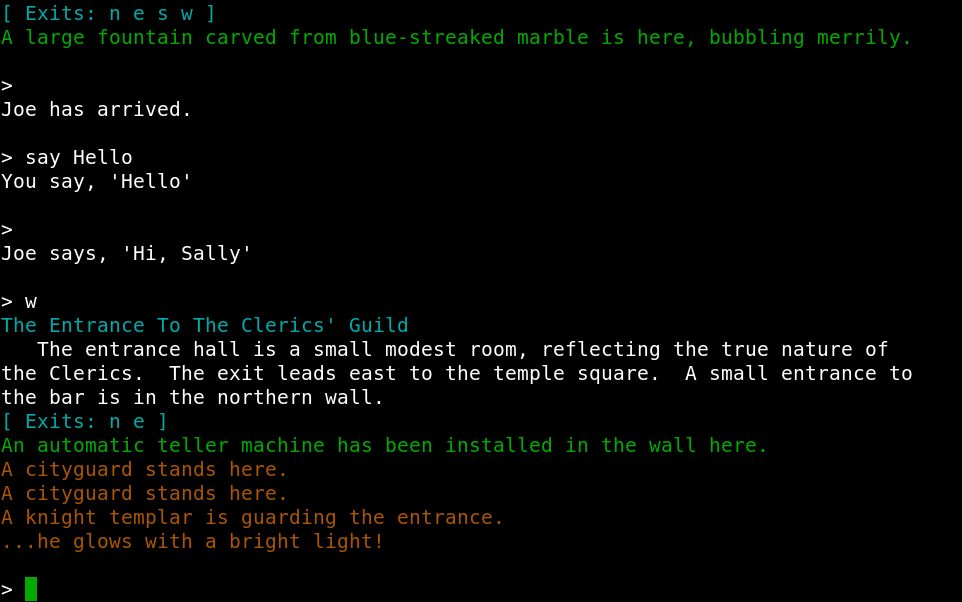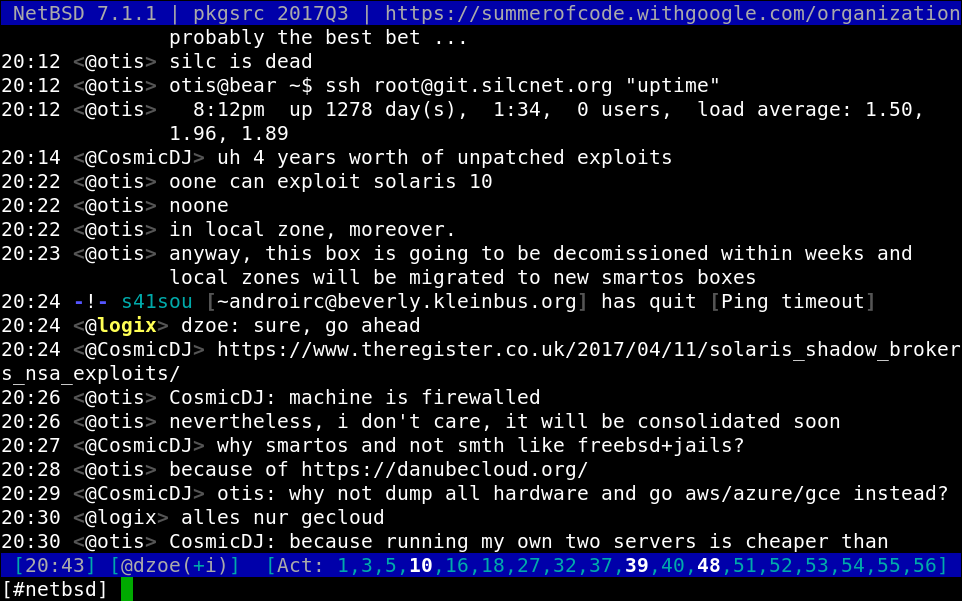Internet messaging - part 2
Written by Dominik Joe Pantůček on 2018-01-11
internetLast week we have discussed some of the emerging methods of communication on the early Internet. We covered the means of communication where the primary target was conveying information to single or multiple recipients and where - at least theoretically - the primary communication intent was work- or research-related. Today we see quite the opposite trend where the communication platforms are originally envisioned for free time communication and only later on the companies try to leverage them for some possible profit. If we look at the dawn of time, we can see that this is nothing new.
Multi User Dungeons (a.k.a. MUDs)
At the beginning, there was the Colossal Cave[1]. Adventure. Or, as the old timers know ADVENT for short. Yes, those were the times when filenames could not be longer than 6 characters and FORTRAN[2] was the basically The standard for any native program development. Written by an experienced caver and programmer Will Crow[3] in the mid-seventies, this game takes you on an adventure of exploring a colossal cave, somewhere in some forest, nearby an old hatch. If you do not know this game, try it - you will not be disappointed. Although it is not an easy one.
With the rise of networking connections, some people were curious whether it would be possible to create an adventure game where multiple players might interact. It turned out it was not only possible, but it also started a new era of online gaming. In 1978, Richard Bartle[4] and Roy Trubshaw wrote the very first MUD[5]. Multi-User Dungeon. A player connects to server using a TELNET[6] connection and controls a character using simple commands. The game - partially asynchronously - writes to the terminal what is going on around the player. This way it is possible to roam around, fight monsters, solve puzzles and eventually "win" the game by achieving an immortal status.
During the 1980's variety of MUDs were created and many of them served as a code-base for further games. Some of them are being maintained by fans - or even commercially - til today. One of the prolific code-bases was the original DikuMUD[7] created by Sebastian Hammer, Michael Seifert, Hans Henrik Stærfeldt, Tom Madsen and Katja Nyboe. Its license forbids any commercial exploitation as at that time, networked servers were mostly available only at universities and the authors did not want anyone to profit from university resources. You can see one of DikuMUD derivatives - CircleMUD[8] - session in picture 1.

Picture 1: TELNET session to CircleMUD server In late 1980's some developers decided to create multi-user applications with the adventure part completely removed. Basically virtual characters would just roam around some rooms and chat. And yes, that is how the term "chatroom" was coined.
Bulletin Board Systems (a.k.a. BBSs)
Roughly at the same time - or actually slightly sooner - as first networked MUDs came out, Bulletin Board Systems (BBS) started to play an important role in online communication. Usually they did not need a stable network connection - just a telephone land line and a modem. The users would then dial-in and use simple text interface to navigate the system. Typically such system consists of multiple bulletin boards where the users can write articles (posts) and other users can read them. Much like nowadays people use web forums or write web diaries - commonly known as weblogs or blogs for short.
But the BBSs were not limited to showing discussion forums and allowing users to post their messages there. These systems usually offered the ability to download published files with longer content and this is where first online software distribution and online independent magazines (e-zines) started.
Actually at least one e-zine, started in 1985, is worth noting here. Phrack[9]. For hackers and by hackers ever since. It gets published irregularly til today and although the original staff is long gone, it has played an important role in the creation of electronic frontier on the network. Last spring I had the opportunity to give a talk about this part of history and as it cannot be summarized quickly I can only suggest you to lookup operation Sundevil[10] and the U.S. versus Craig Neidorf and U.S. Secret Service versus Steve Jackson Publishing cases[11]. Or maybe just read The Hacker Crackdown[12] by Bruce Sterling to get the idea what was this era of BBSs about.
Internet Relay Chat
Mostly standardized in late 1980's, the Internet Relay Chat[13] was immediately addictive for anyone with stable network connection. You join chat rooms, called "channels" here, you write your messages and others on the same channel read them. Typical IRC client can connect you to multiple channels - even on multiple servers - and switch between them as you want to read them. Also it can notify you wen there is someone writing on another joined channel you are not reading at the moment.
Looking at picture 2 should give you a good impression how a typical IRC channel looks like. The channel depicted there is #NetBSD and it is the place where people interested in the NetBSD[14] operating system hang and informally chat. Although there is nothing "official" about it, you usually find someone to help you with variety of BSD-related problems there.

Picture 2: Internet Relay Chat, channel #NetBSD on IRCNet Apart from communication on channels, it is possible to talk directly to other users without anyone seeing what you are up to. But you should not rely on bare IRC for any message confidentiality. Although it is possible to connect to many IRC servers using TLS[15] nowadays, it is also true that even then the administrators of those servers or other internal IRC infrastructure can read your messages with little to no effort.
There are possibilities to employ end-to-end encryption, but they are convenient only for very specific meaning of the word "convenient". If you are a programmer who is happy to write scripts for his favorite communication program, you will be more than satisfied. Otherwise, you might find using end-to-end encryption slightly complicated.
All in all it looks like in ye g'd ol' times there was a heck of real social life on the Internet - and that was long time before the Web was born. We are about to finish this communication mini-series next week so be sure to get back here then!
References
-
Colossal Cave Adventure. (2017, December 31). In Wikipedia, The Free Encyclopedia. Retrieved 21:25, January 1, 2018, from https://en.wikipedia.org/w/index.php?title=Colossal_Cave_Adventure&oldid=817890912
-
Fortran. (2017, December 23). In Wikipedia, The Free Encyclopedia. Retrieved 21:26, January 1, 2018, from https://en.wikipedia.org/w/index.php?title=Fortran&oldid=816703075
-
William Crowther (programmer). (2017, August 14). In Wikipedia, The Free Encyclopedia. Retrieved 21:28, January 1, 2018, from https://en.wikipedia.org/w/index.php?title=William_Crowther_(programmer)&oldid=795404942
-
Richard Bartle homepage, available online at http://mud.co.uk/richard/
-
MUD, British Legends - the original Multi User Dungeon, available online at http://www.british-legends.com/CMS/
-
RFC 854: TELNET PROTOCOL SPECIFICATION, Network Working Group, May, 1983
-
DikuMUD. (2017, December 5). In Wikipedia, The Free Encyclopedia. Retrieved 21:33, January 1, 2018, from https://en.wikipedia.org/w/index.php?title=DikuMUD&oldid=813797194
-
CircleMUD homepage, available online at http://www.circlemud.org/
-
Phrack underground magazine, available online at http://phrack.org/
-
Operation Sundevil. (2017, December 15). In Wikipedia, The Free Encyclopedia. Retrieved 21:41, January 1, 2018, from https://en.wikipedia.org/w/index.php?title=Operation_Sundevil&oldid=815498114
-
Steve Jackson Games, Inc. v. United States Secret Service. (2017, December 16). In Wikipedia, The Free Encyclopedia. Retrieved 21:42, January 1, 2018, from https://en.wikipedia.org/w/index.php?title=Steve_Jackson_Games,_Inc._v._United_States_Secret_Service&oldid=815639021
-
Sterling, Bruce. The hacker crackdown : law and disorder on the electronic frontier. New York: Bantam, 1993. Print. ISBN 0-553-56370-X
-
RFC 1459: Internet Relay Chat Protocol, Network Working Group, May, 1993
-
NetBSD project, "of course it runs NetBSD", available online at http://netbsd.org/
-
RFC 5246: The Transport Layer Security (TLS) Protocol Version 1.2, Network Working Group, August, 2008
